Imagine that you could talk to each one of your online customers individually. Every single one of them treated as a human and not an order number. Well, implementing triggered emails on your eCommerce site is a fantastic way to deliver that personalized service at scale. The results speak for themselves – our clients typically see ROI from their eCommerce email marketing automation projects in 3 months or less.
The key to triggered emails is personalization. Instead of setting up a one-size-fits-all email campaign, you can develop emails that are automatically sent to visitors after they perform actions on your site. Every email is sent based on customer behavior.
Through personalization, you can craft laser-focused emails that are targeted to a particular segment of your audience. Because of their clear agenda, triggered emails have an open rate that is 70% higher than their counterparts; email newsletters. Triggered emails also help increase your earnings by as much as 760%, according to Campaign Monitor.
Are you using triggered emails in your eCommerce email marketing strategy?
If you want to start using triggered email marketing automation to drive more sales to your store. Here are the first 5 triggered emails I’d implement. Of course if you need help with this, we’d love to help and you can read more about our email marketing services here.
1. Abandoned Cart Emails
There are many reasons why people abandon their online shopping carts, and big brands aren’t immune to shopping cart abandonment boasting a 68.63% abandonment rate. That is literally millions of abandoned dollars 💰 every month. We see cart abandonment as one of the biggest ways to recover lost revenue in eCommerce and we even made a Pinterest board dedicated to cart abandonment emails.
Seize the opportunity to recover lost revenue with a series of triggered cart abandonment emails. These emails can be as simple as a small nudge reminding your customers of the goods in their cart and providing them a seamless way to return to checkout.
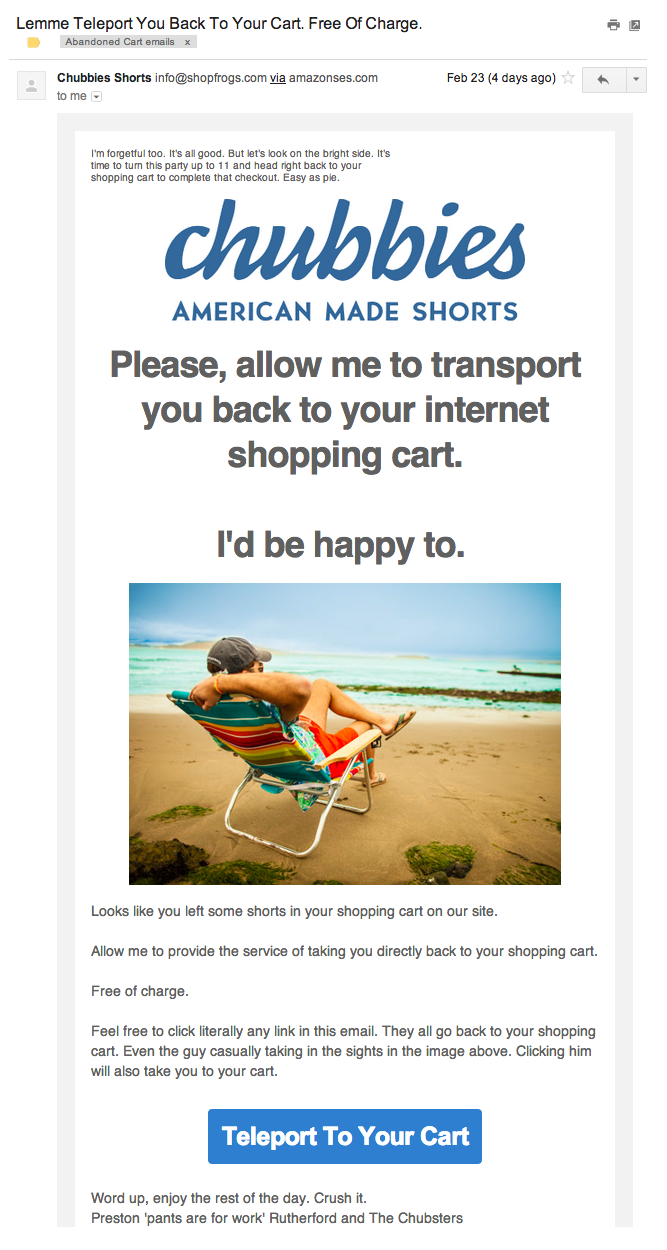
An example of a great abandoned cart email is from Chubbies. All elements of the email click, (great copy, clean design, big CTA button) and compel the receiver to check out their cart.
One of our clients SKICKS A/B tested their cart abandonment emails and is now generating $10,000+ more a month after seeing a 49% lift in one of their content email experiments.
To determine how you must approach your triggered emails for abandoned carts, you need to identify the possible reasons why your customers are abandoning checkout in the first place. Check out the image below from the study conducted by UPS to learn the possible reasons why visitors are leaving their carts in your site.
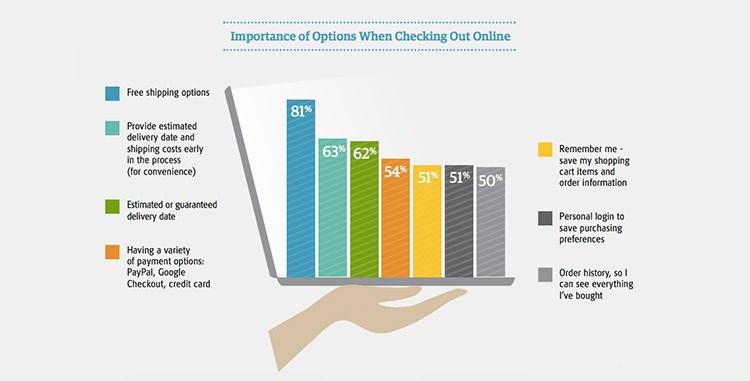
For example, if you feel that your shipping costs are scaring buyers away, you can send an email offering them a discount promo so they can come back and complete the order.
Another great example is Hammock Town who tests a humorous approach to selling hammocks online. Their copy and imagery aren’t an annoying attempt to get you to buy, but a gentle reminder that makes you laugh if you read the email.
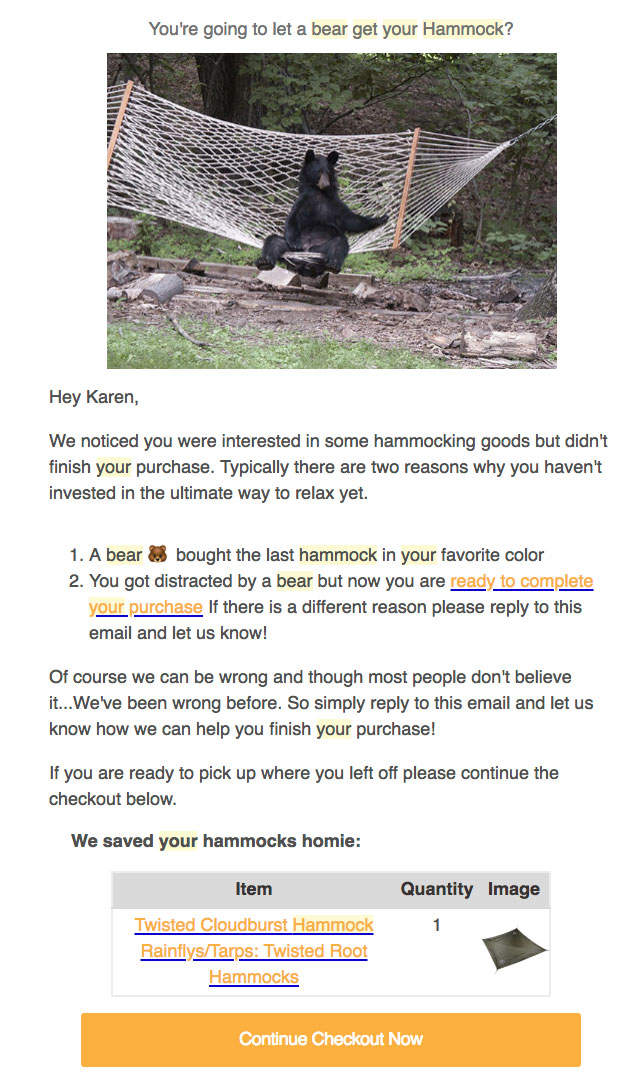
If you require help with abandoned cart email marketing, look no further than our eCommerce email marketing services to help recover abandoned carts from your site and send them responsive emails to hike up your conversion rate. Check out this post at Shopify for more impressive examples of this type of emails.
2. Related Product Recommendation Emails
Closing a sale is half the battle. The other, and arguably harder half is to get the customers to purchase again from your site.
Existing buyers already have one foot in your proverbial door, there is a 60-70% chance of getting back into their good graces according to the book “Marketing Metrics.” If it’s 4 to 10 times less expensive to re convert an existing customer than it is to acquire a new customer, than why aren’t we investing more in marketing to drive up our customers lifetime value?
Take advantage of the low costs and ease of getting loyal customers to buy again, the key here is to send them content that adds value. Hammock Town also does a fantastic job at this with their Cacoon Hammocks. If someone purchases one of these hanging pods from Hammock Town, they will get a series of emails sent to them with Klaviyo one of our preferred ESPs.
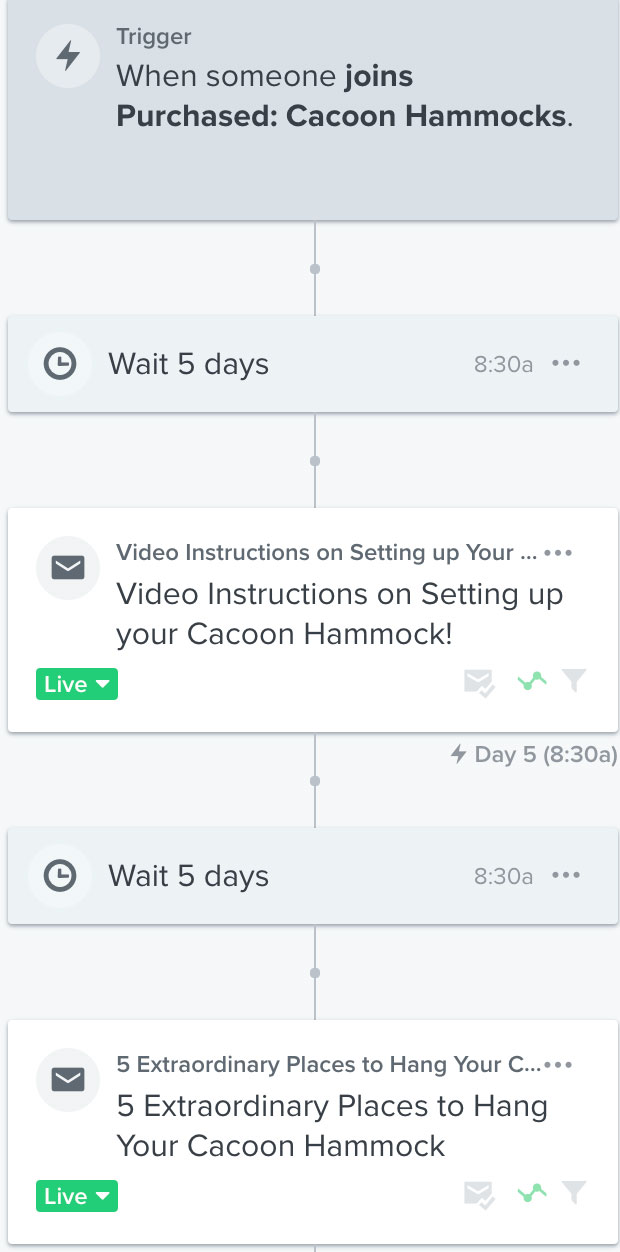
Hammock Town set up a series of 3 emails after someone purchases a Cacoon Hammock.
Email 1: 5 Days Post Purchase (This is important because your customer might not have their product yet)
Hammock Town does this with class and let’s them know they can track their shipment. The last thing you want, are 100 emails sent to you asking where your hammock is! Here is their copy and a screenshot of the first triggered email. They deliver value the first email and do not try to make a sale.
“Howdy!
If you have yet to receive your Cacoon Hammock you can login to your account to track your shipment.
But… we just wanted to make sure you had these video instructions handy so your Cacoon Hammock setup is super simple!”
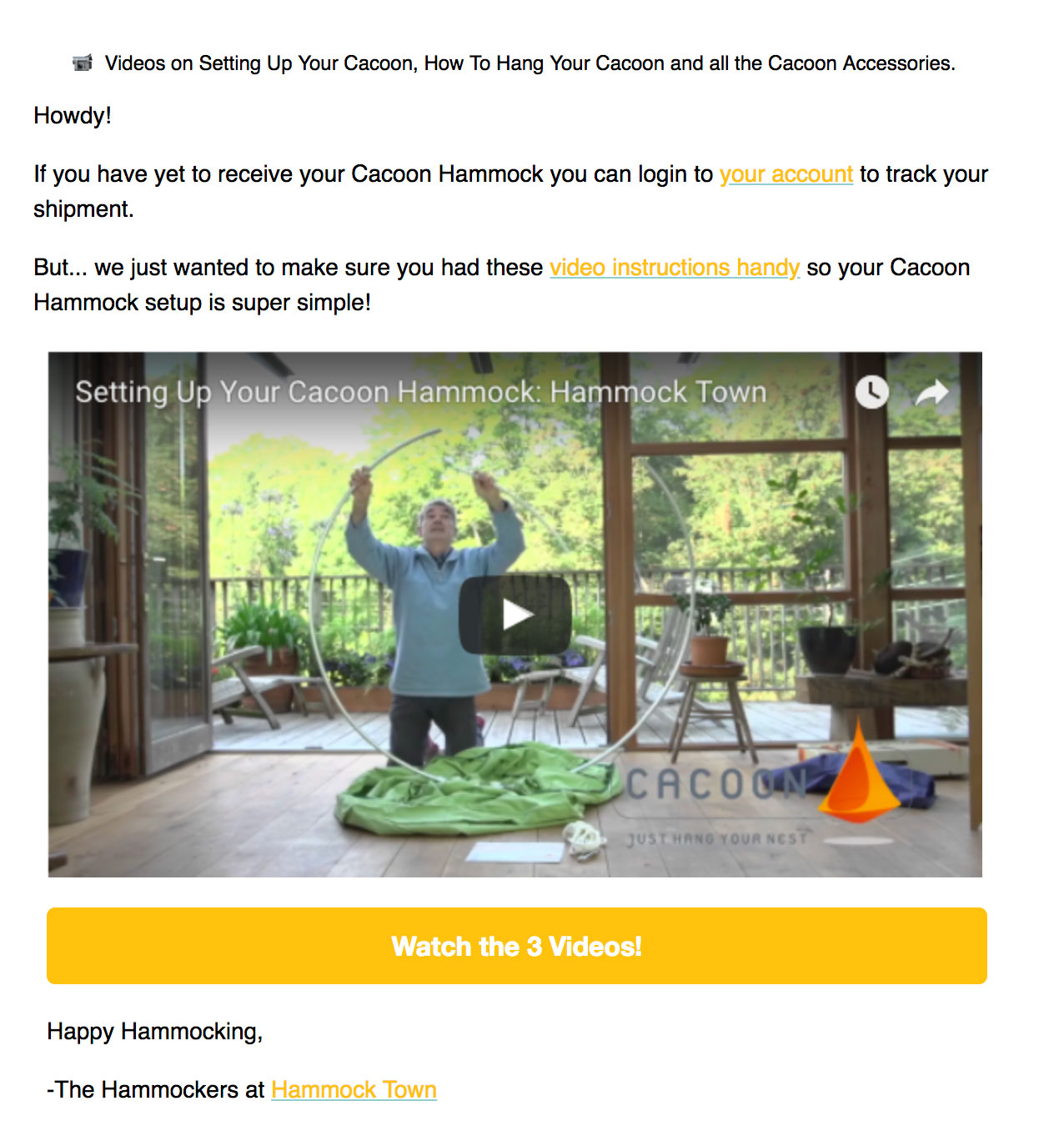
Email 2: 10 Days Post Purchase
In the second email, your customer should already have their product. This email should inspire them to get out and use the product. Hammock Town delivers value again by showing their customers a rad picture and driving them to a blog post, encouraging them to go on an adventure. In any industry, SaaS, eCommerce, Media, the way you prevent churn and returns is by ensuring you have customers using your products.
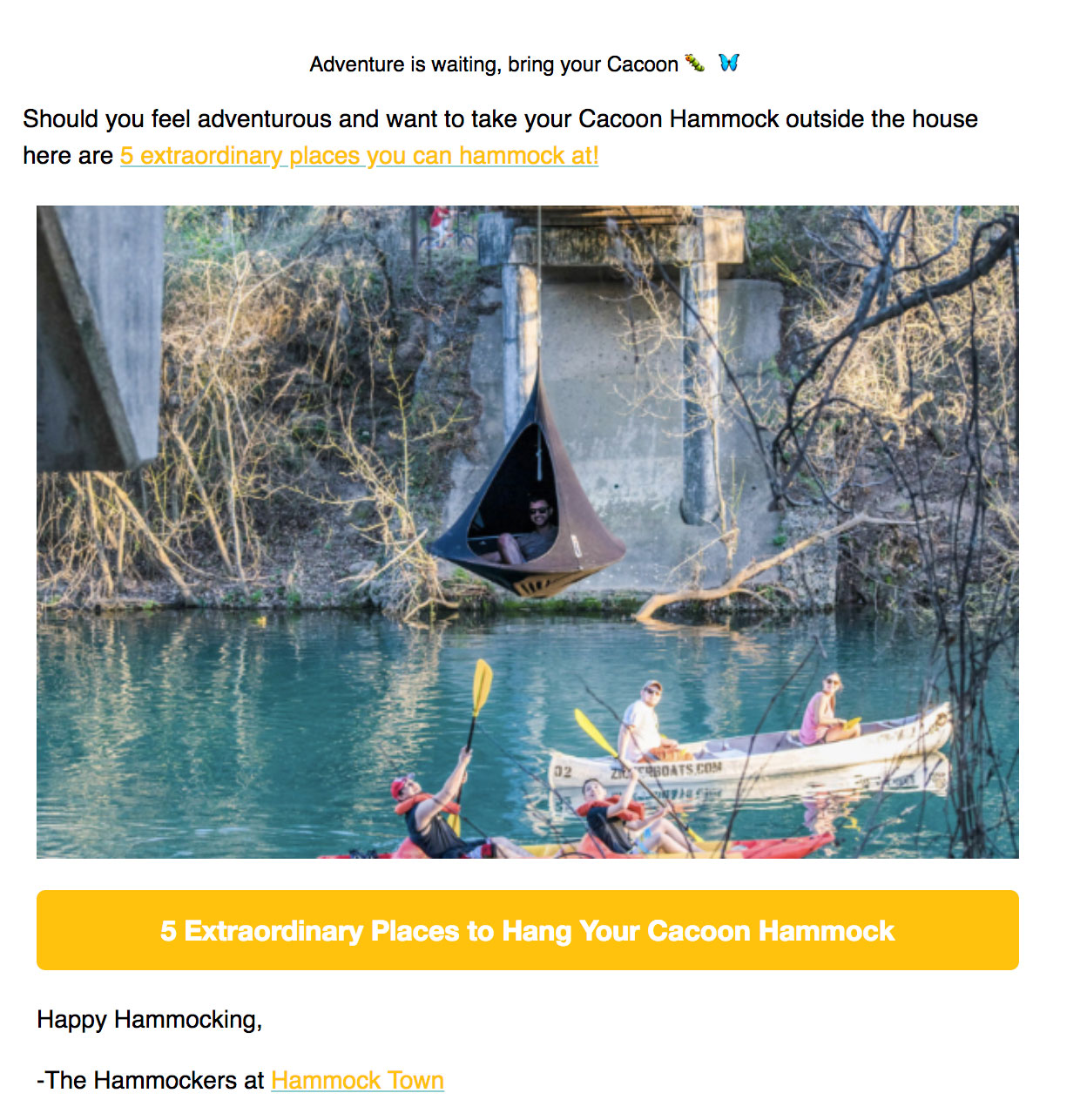
Email 3: 15 Days Post Purchase
This is where Hammock Town delivers value again. In this 3rd automated email sent 15 days post purchase, Hammock Town offers the Cacoon owners 10% off Cacoon Hammock Accessories.
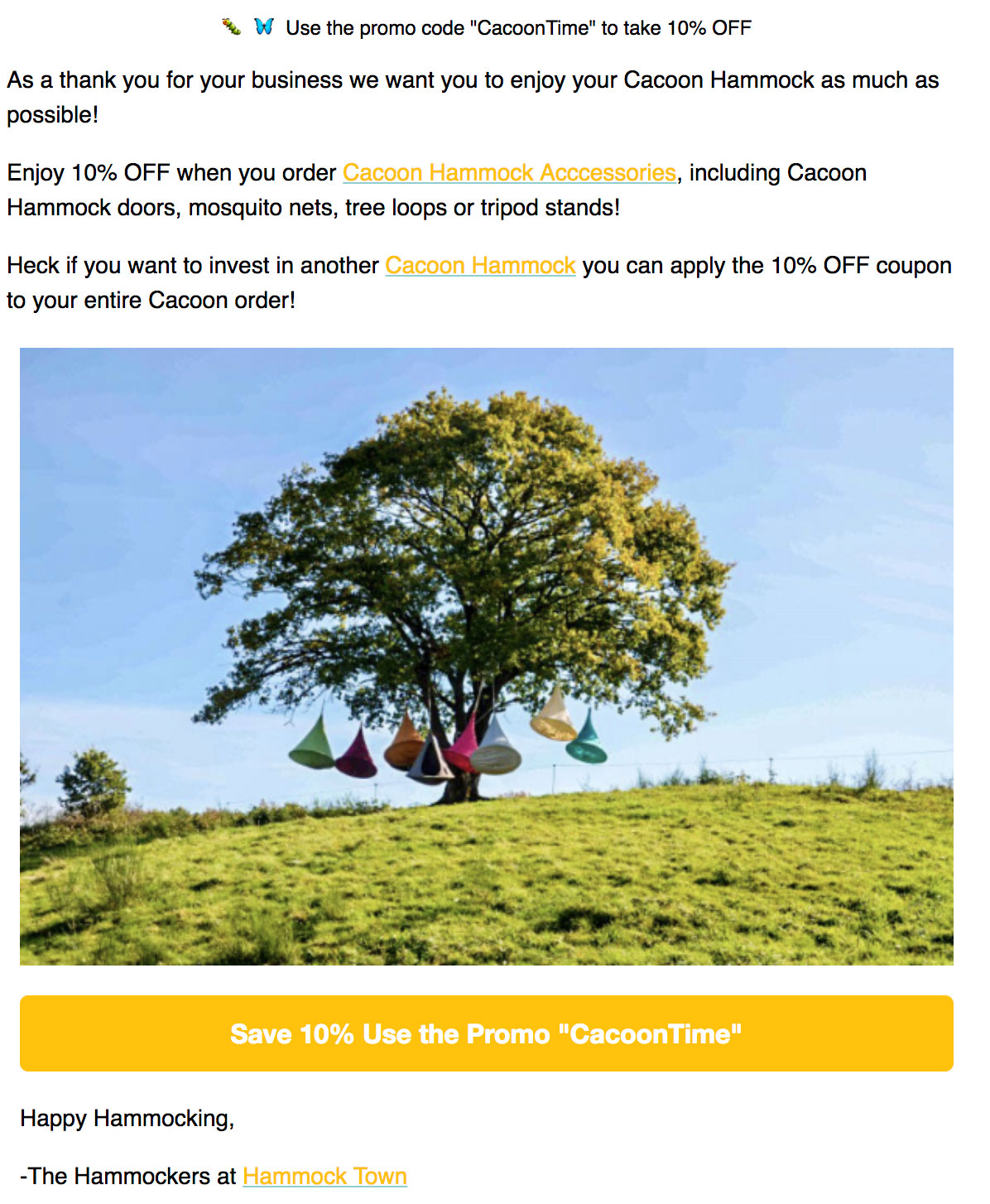
This tactic also applies to users who searched a term on your site. In this post at Hubspot, the team searched for pumpkin masks at Amazon to wear on Halloween. After a couple of days, Amazon sent an email to the team with product recommendations from other users who searched for the same term.
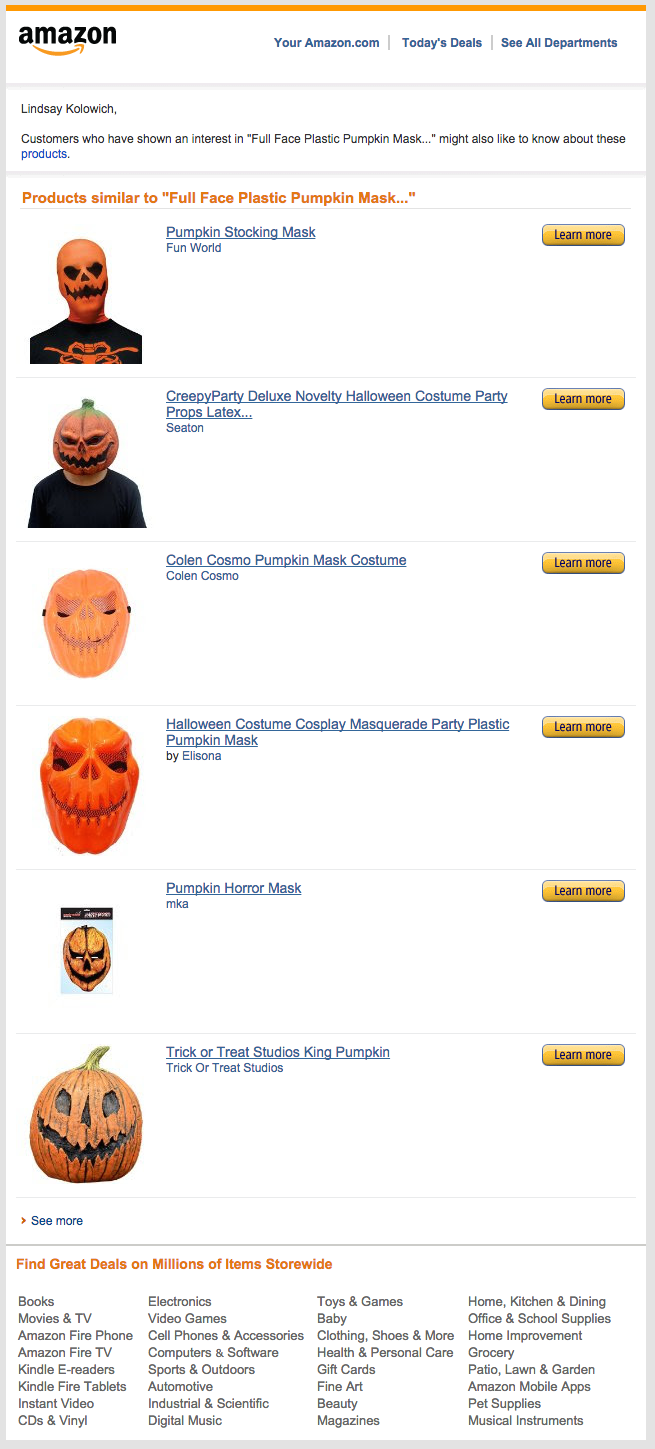
While the email Amazon involves lots of moving parts, you can only start by crafting an email that recommends other products related to your most popular ones. Customers buying the popular product will trigger the email to be sent their way so they can also take a look at your other products.
3. Post-Purchase Review Email
You want to understand the kind of audience you are attracting to your site so you can make the changes that will lead to more buyers in the future. You can start by tapping into your customers by sending them an email asking them to answer a survey or write a review about their experience ordering from your site or the actual product they purchased.
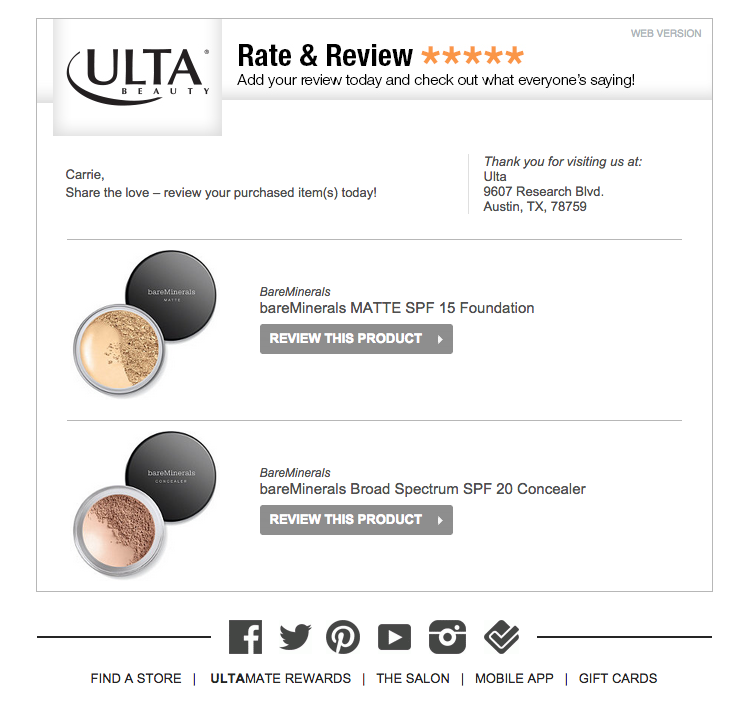
In this post-purchase review email from Ulta, their objective is to interact and further engage customers with their site. Rack Simply also does a great job with their post purchase email. Sent 14 days after purchase, they focus on customer service on their product review email.
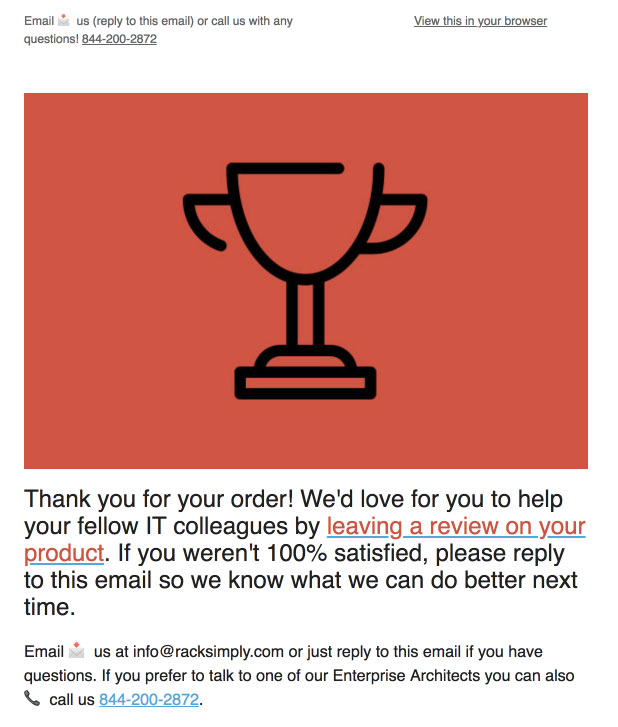
The review is used by the site as a platform for customers to voice out their thoughts about the products and get them to check out what other people are saying about it. For more compelling examples of this type of emails, head on to this post at TowerData.
4. Loyalty Reward Emails
If you have customers who keep coming back for more on your online store, then you are doing something right. Return the favor by offering them exclusive deals and discounts from your shop so show how thankful you are for their continued support. Also, rewarding them is an excellent way to get in touch with loyal customers on a deeper and personal level.
A loyalty program is crucial in keeping your customers, especially if you target millennials. 68% of them believe that there is no point in staying with a business that does not reward their loyalty.
Even if you do not target this demographic, a loyalty program reassures customers that all their purchases are not in vain.
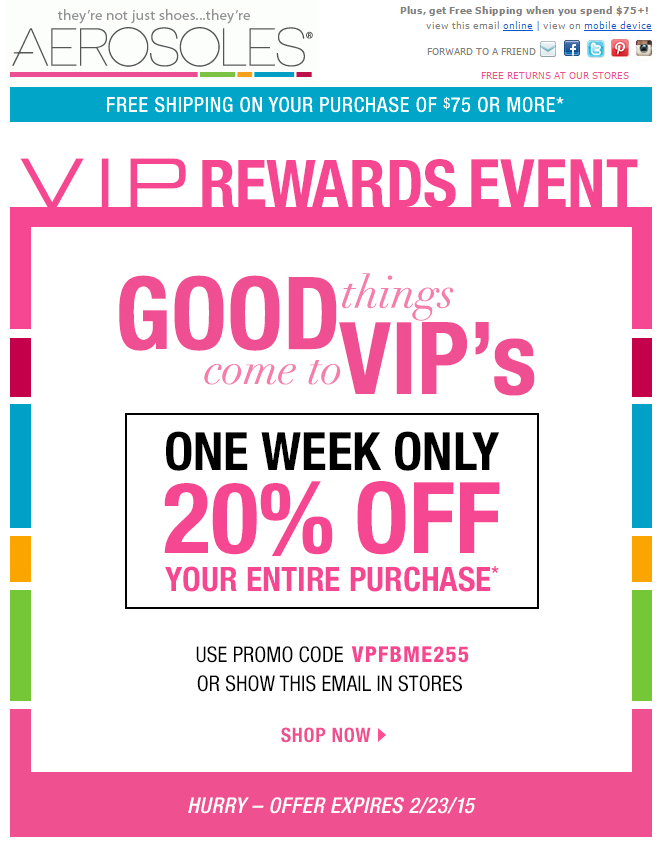
This Aerosoles email featured in StoreYaBlog is a simple yet effective example of rewarding loyal customers. The multiple times “VIP” is repeated in the message puts emphasis on the exclusivity and sensitivity of the email. It also reassures the important customers that they are prioritized above others.
Peak-Ryzex Direct also does a phenomenal job at crafting emails that get their customers coming back. With a series of 3 emails they generated over $1,000 in revenue in the first month of their emails being set up. This is incredible consider the low traffic on this mostly b2b industry.
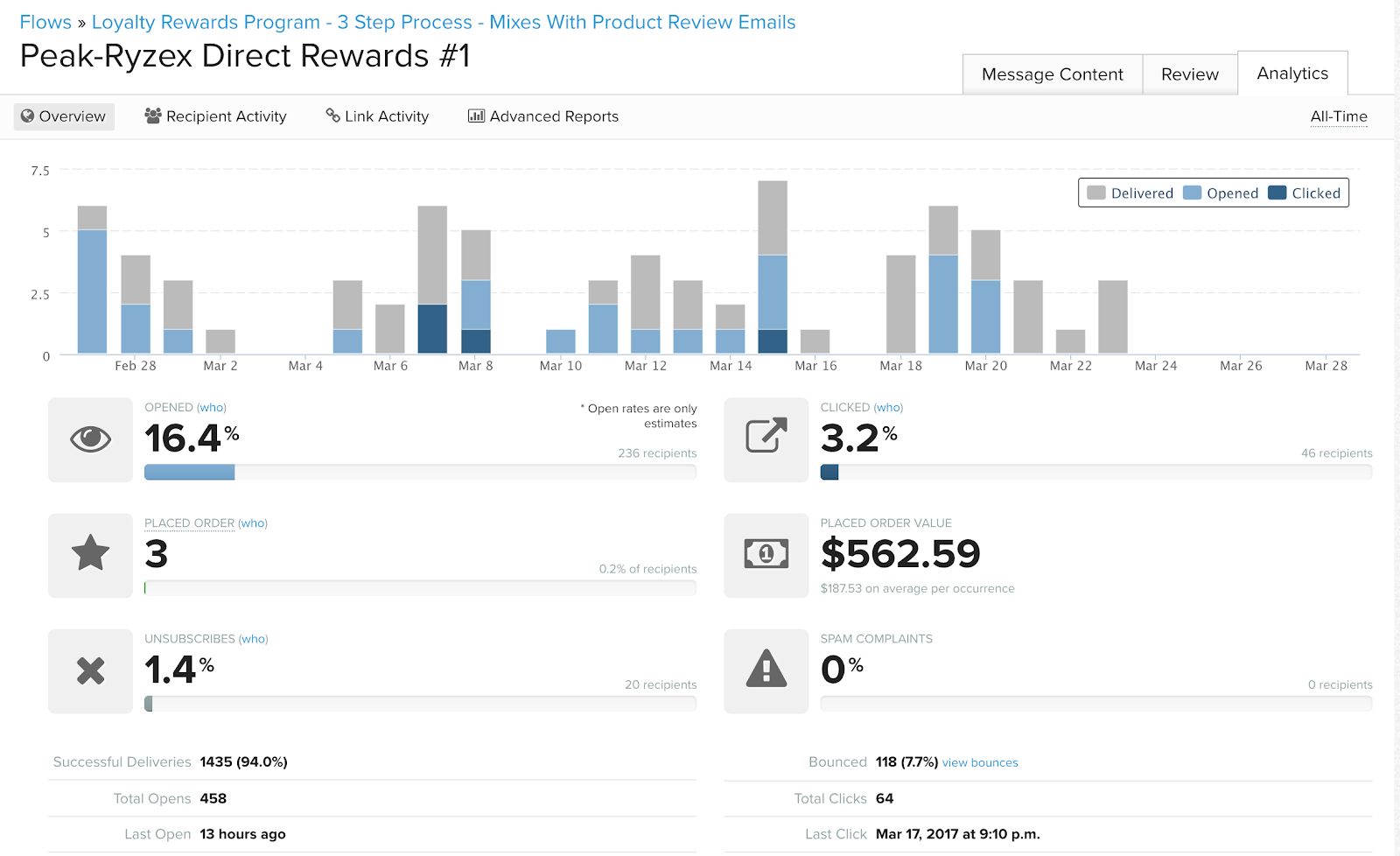
Email 1: Delivered 4 Days Post Purchase 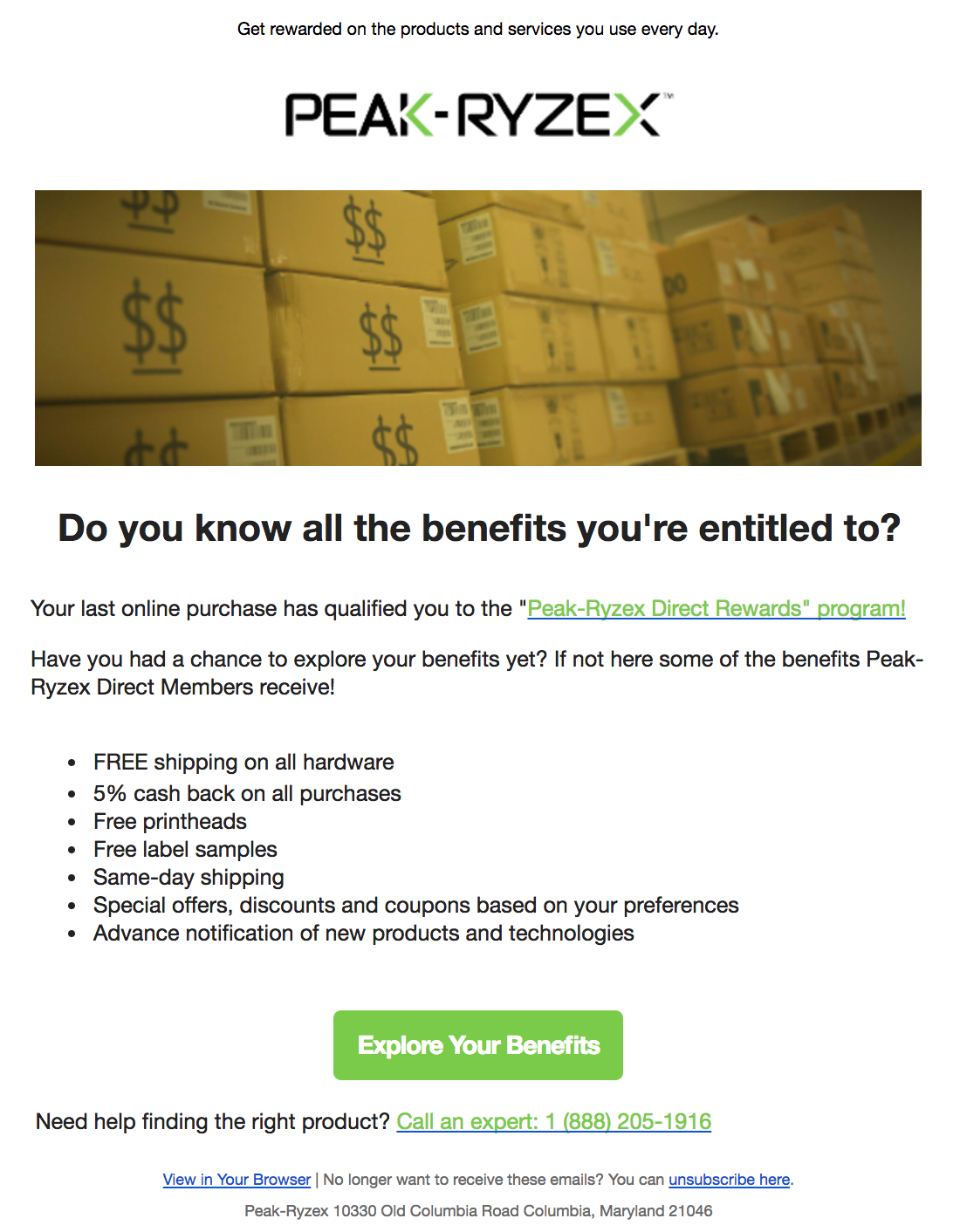
Email 2: Delivered 22 Days Post Purchase
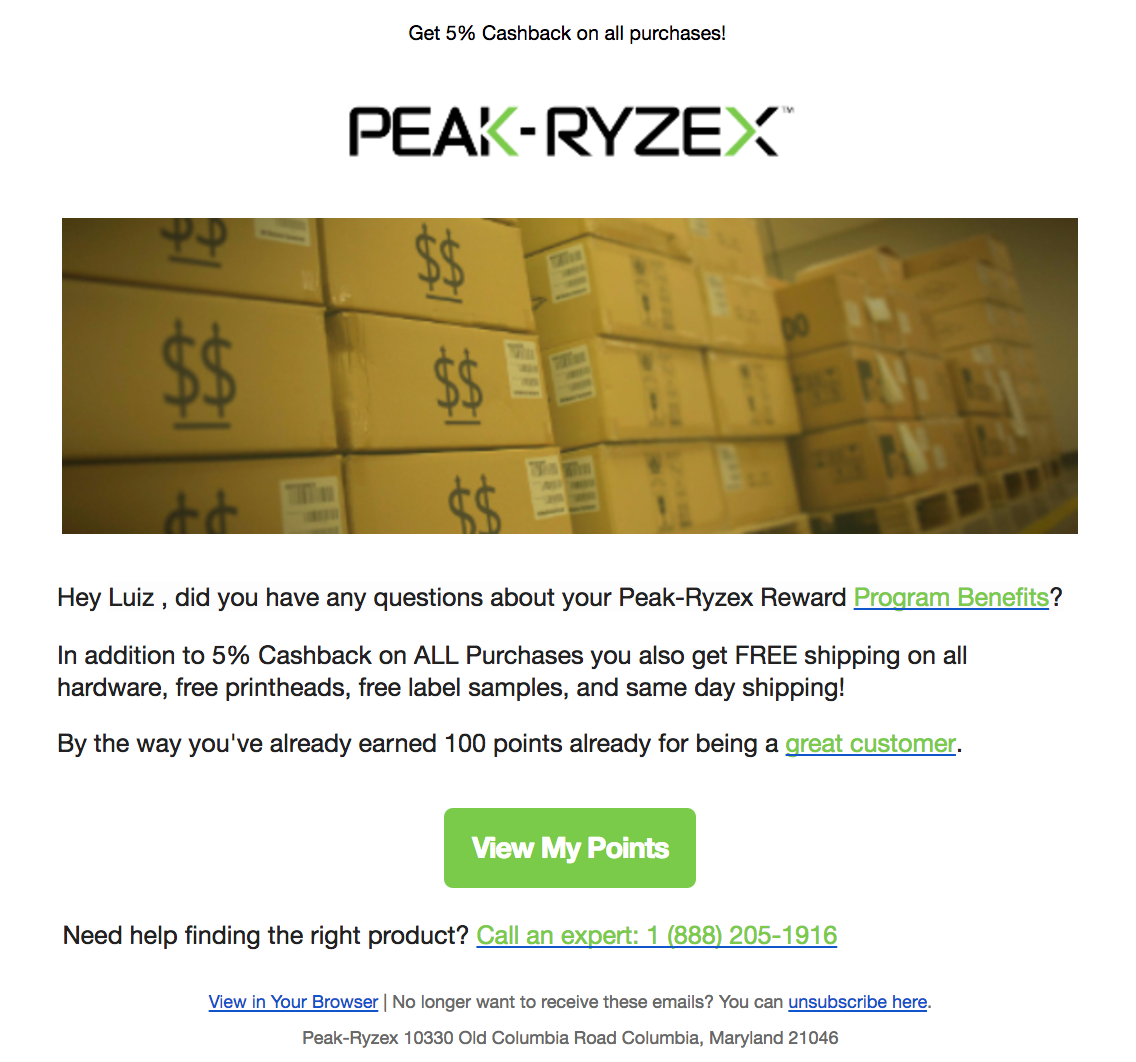
Email 3: Delivered 40 Days Post Purchase

Notice that all these emails focus on the customer, they add value, and they aren’t salesy.
By fulfilling these factors, you can strengthen their loyalty and encourage them to purchase even more from your online store.
5. Re-engagement Emails
Over time, there is a chance that your customers and subscribers will tune out from using your site to purchase products, and you’ll need to remind them why they purchased from you in the first place.
Not only are repeat customers more cost effective than than new customers, they also are willing to spend 67% more than new customers.
A re-engagement email works best if it is part of a bigger campaign, but it is a start to help make your previous customers realize that your shop still exists and is as awesome as ever.
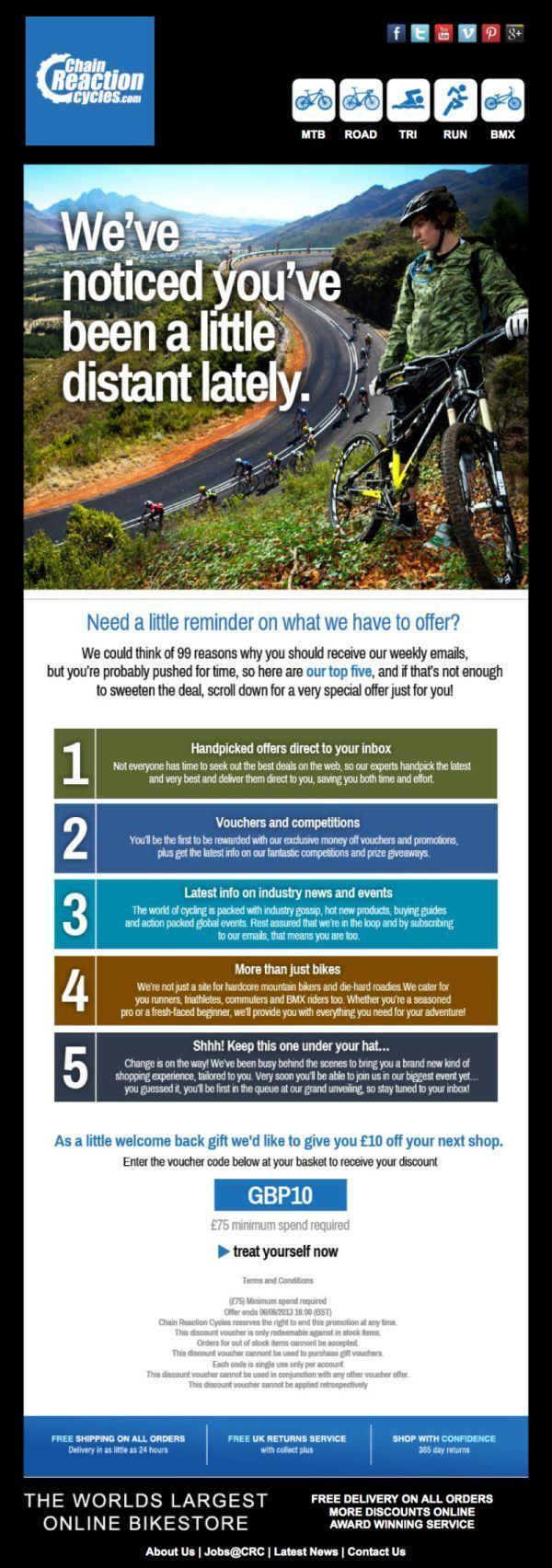
Chain Reaction Cycles plays their re-engagement email straight up with a great header image to illustrate how distant you have become in using their services. However, the most important part of the email comes after the image, in which the brand lists down five reasons why you must reconnect with them. These serve as reminders on why you signed up with them in the first place. There are other examples of this type of emails in this post at IMPACT Branding & Design.
Now, we turn the tables to you – Have you tried some of the examples listed above? What were your results and takeaways that you got from them? Also, what other triggered email campaigns that you are using to drive more revenue to your e-commerce sites?

